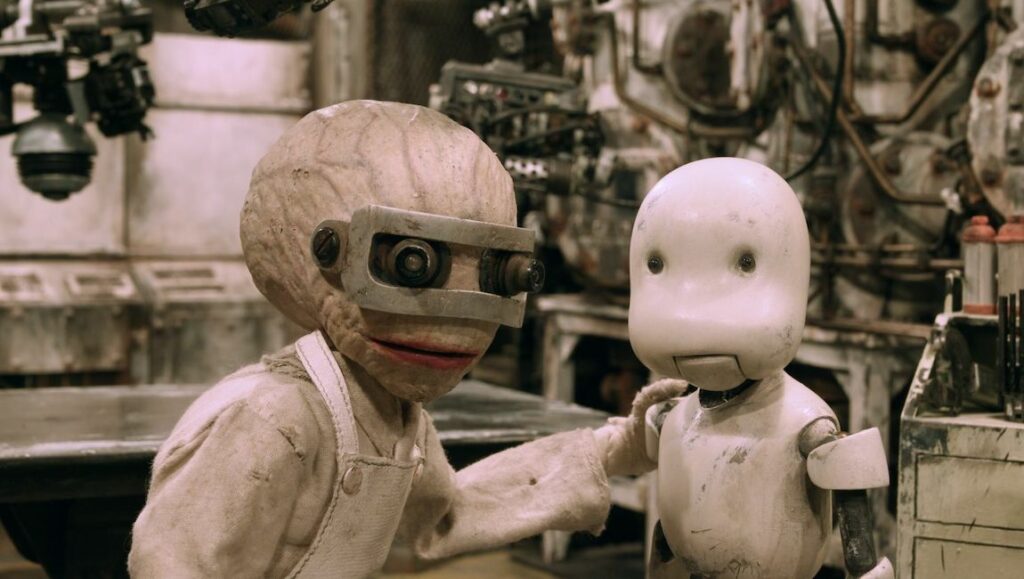A stop-motion animated epic over seven years in the making, Junk Head is the work of one obsessively dedicated man, Takahide Hori. An interior decorator by trade, Hori embarked on his passion project with no formal filmmaking training, inspired by the homemade computer animations of Makoto Shinkai (best known for the blockbuster anime Your Name) and a desire to do something productive with his nagging artistic impulses. Hori began Junk Head in 2009 as his own director, cinematographer, sound designer, and puppeteer, going online to learn how to make malleable figurines, and finally released a 30-minute short film titled Junk Head 1 in 2013. The short garnered Internet acclaim and a very vocal fan in filmmaker Guillermo del Toro. After securing additional funding, Hori continued working on the project: he finally enlisted some outside assistance and eventually released a feature length version in 2017 (IMDb lists that version as 115 minutes long). Now, a newly edited version is being released, clocking in at slimmer 100 minutes. It’s hard to discern exactly what’s been trimmed in this new, shorter version (being touted as “leaner and meaner” by festival press), as there’s little traditional narrative to speak of. What is here is an abundance of outlandishly wild imagery, breathtakingly creative and frequently disgusting in equal measure.
A brief opening scrawl sets up Junk Head’s dystopian future scenario: As humans developed gene therapies to prolong life, they eventually lost the ability to procreate. Mankind created “marigans” as slave labor to work underground, but they revolted and fomented a rebellion. Now, 1600 years in the future, a virus is wiping out what’s left of humanity above ground. In an effort to study marigans and their reproductive abilities, scientists have launched an ecological surveyor deep underground to understand these creatures and the society they’ve built. It’s a lot of information to take in, and Hori doesn’t seem particularly concerned with providing a full taxonomy of all the strange creatures that he’s populated his film with. Instead, the audience stumbles around this labyrinthine underworld with our intrepid explorer, who is tasked with finding a genetic sample from a marigan reproductive organ.
And what an underworld it is: equal parts Metropolis, Blade Runner, and Eraserhead, with a healthy dose of Cronenbergian body horror. It’s also quite funny, pitching its weird blend of cyber- and steam-punk as absurdist comedy. Like a lot of Japanese animation, there’s a fascination here with combining the organic and the mechanical. A psychoanalyst would have a field day with all the climbing in and out of orifices, as the explorer is constantly sucked into and expelled out of cavernous spaces. Our explorer encounters all manner of life forms, humanoid and not, and transfers consciousness between various robotic bodies several different times. It’s a wild ride, all improbably hand-crafted by Hori. His models are elaborately detailed hermetic worlds, every square inch covered in rich textures and complicated lattice works of tubes, pipes, screens, and rubble (there are some optical effects here and there and a few CGI shots of fire, smoke, and dust, but everything else is a physical object). Noseless human clones rub shoulders with the marigans, weird creatures that look like a cross between big-toothed snakes and the Chimeras from Resident Evil. Dune-esque worms dig through walls and leave red, vein-like webbing to ensnare their food. Phallic appendages are used as both food and currency, and armless, legless torsos that grow tumorous pustules are arranged like cooped up chickens.
There’s an endless variety of stuff, all of it viscerally tangible. Shooting on large sets allows much of the film’s lighting to be practical, creating real shadows and adding volume to individual objects. As more than a few critics have noted, Junk Head frequently gives the impression of a big kid playing with their toys, mashing them together and ripping them apart with equal aplomb. The film does occasionally feel childish, but in a good way; mostly freed from narrative constraints, Junk Head oscillates wildly from the grotesque to the cute, including its very own version of Minions and a bevy of chittering critters that coo and squeak like a child’s favorite stuffed animal. A little of this sort of thing can go a long way, and some of the vignettes are more successful than others. Indeed, even in this shorter version it’s an exhausting experience. Still, there’s much to admire here, and fans of adult animation absolutely cannot miss it. Hori is the real deal; let’s hope next time it doesn’t take him quite so long to make another film.
Published as part of Fantasia Fest 2021 — Dispatch 2.


Comments are closed.